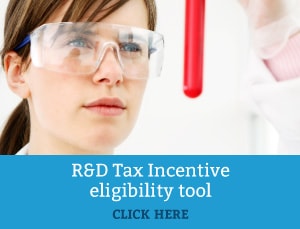A Snapshot of the R&D Tax Incentive
April 5th, 2016With the 30 April deadline to register fast approaching, firms need to review their eligibility and start working on their application as soon as possible, or risk missing out. In light of this, we’ve provided a snapshot of the program and the eligibility requirements.
The research and development (R&D) tax incentive came into effect on 1st July 2011 and encourages companies to engage in R&D by providing a tax offset for eligible R&D activities. The program is administered jointly by AusIndustry (on behalf of Innovation Australia) and the ATO. For eligible entities with a turnover of less than $20 million pa the R&D tax incentive is a 43.5% refundable tax offset (equivalent to a 150% tax reduction).
The requirements to be eligible for the R&D Tax Incentive include:
- Must register the R&D activities each year with AusIndustry prior to making a claim for the R&D tax incentive in the company tax return (NB: Due April 30).
- Must be an R&D entity, i.e. company.
- Must be engaged in eligible R&D activities.
- Have notional R&D deductions of at least $20,000 for the year.
Eligible R&D activities typically pertain to only R&D activities conducted in Australia. To be eligible for the R&D tax incentive the activities must be classified as either core R&D activities or supporting R&D activities.
Core activities are experimental activities whose outcome cannot be known or determined in advance on the basis of current knowledge, information or experience, but can only be determined by applying a systematic progression of work that:
- is based on principles of established science; and
- proceeds from hypothesis to experiment, observation and evaluation, and leads to logical conclusions; and
- that is conducted for the purpose of generating new knowledge (including new knowledge in the form of new or improved materials, products, devices, processes or services).
Supporting activities are activities that do not constitute core activities, but are directly related to core R&D activities.
In short, core R&D activities are essentially the experimental undertakings conducted to generate new knowledge (The R&D Tax Incentive: Glossary of Frequently Used Terms). However, it is vital to note that activities must show that they are undertaken for the dominant purpose of supporting R&D activities or generating new knowledge, rather than a commercial or other purpose.
To illustrate, Figure 1 shows the four parts of a systematic progression of new knowledge generation.
As Figure 1 reveals, a core R&D activity will typically commence after a hypothesis has been developed. This is because the activities associated with developing a hypothesis are more likely to qualify as supporting R&D activities (for example, literature searches, background research, consultation with industry professionals, to thereby inform the design of a core (experimental) activity).
In contrast, the activities undertaken to test the hypothesis are much more likely to be considered a core R&D activity. This includes the design and conduct of the expirement, observation and evaluation of results (what was observed, changed, discovered), and the drawing of logical conclusions.
To make the process easier, we’ve put together an infographic which indicates the activities that do not qualify for the R&D Tax Incentive. You can download the PDF to print or save here: Examples of Non Core R&D Activities. In a previous blog post, we delved into what is considered ineligible expenses and expenditure.
If you think your company may be eligible, have a discussion with one our R&D tax specialists who will be able to answer any further questions or help you make your claim.
Categories
- ATO Guidance and Materials
- AusIndustry Guidance and Materials
- Case Law
- Federal Budget 2021
- Federal Budget 2022
- Federal Budget 2024
- For Accountants
- General Information
- Government Policy and Treasury
- Industry Specific Issues
- Interpretative Decisions
- Legislation and Parliamentary Matters
- R&D Tax Credit
- R&D Tax Funding Strategies
- R&D Tax Loans
- Recent News
- Tax Determinations
Archives
- July 2024
- June 2024
- May 2024
- April 2024
- March 2024
- February 2024
- January 2024
- December 2023
- November 2023
- October 2023
- September 2023
- August 2023
- July 2023
- June 2023
- May 2023
- April 2023
- March 2023
- February 2023
- January 2023
- December 2022
- November 2022
- October 2022
- September 2022
- August 2022
- July 2022
- June 2022
- May 2022
- April 2022
- March 2022
- February 2022
- January 2022
- December 2021
- November 2021
- October 2021
- September 2021
- August 2021
- July 2021
- June 2021
- May 2021
- April 2021
- March 2021
- February 2021
- January 2021
- December 2020
- November 2020
- October 2020
- September 2020
- August 2020
- July 2020
- June 2020
- May 2020
- April 2020
- March 2020
- February 2020
- January 2020
- December 2019
- November 2019
- October 2019
- September 2019
- August 2019
- July 2019
- June 2019
- May 2019
- April 2019
- March 2019
- February 2019
- January 2019
- December 2018
- November 2018
- September 2018
- July 2018
- June 2018
- May 2018
- April 2018
- March 2018
- February 2018
- January 2018
- December 2017
- November 2017
- September 2017
- August 2017
- July 2017
- June 2017
- May 2017
- April 2017
- March 2017
- February 2017
- January 2017
- December 2016
- November 2016
- October 2016
- September 2016
- August 2016
- July 2016
- June 2016
- May 2016
- April 2016
- March 2016
- February 2016
- January 2016
- December 2015
- November 2015
- October 2015
- September 2015
- August 2015
- July 2015
- June 2015
- May 2015
- April 2015
- March 2015
- February 2015
- January 2015
- November 2014
- October 2014
- September 2014
- August 2014
- July 2014
- June 2014
- May 2014
- April 2014
- March 2014
- February 2014
- January 2014
- December 2013
- November 2013
- October 2013
- September 2013
- May 2013
- April 2013
- March 2013
- September 2012
- August 2012
- June 2012


 Free Call: 1800 792 676
Free Call: 1800 792 676







 News & Research
News & Research



